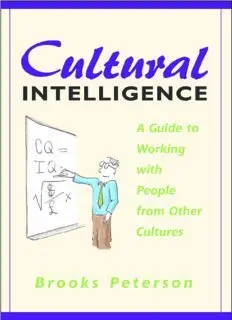
Cultural Intelligence: A Guide to Working with People from Other Cultures PDF
Preview Cultural Intelligence: A Guide to Working with People from Other Cultures
Published by Intercultural Press in 2004. Intercultural Press, Inc. Nicholas Brealey Publishing PO Box 700 3–5 Spafi eld Street Yarmouth, Maine 04096 USA London, EC1R 4QB UK Tel: 207-846-5168 Tel: +44-(0)207-239-0360 Fax: 207-846-5181 Fax: +44-(0)207-239-0370 www.interculturalpress.com www.nbrealey-books.com © 2004 by Brooks Peterson All rights reserved. No part of this publication may be reproduced in any manner whatsoever without written permission from the publisher, except in the case of brief quotations embodied in critical articles or reviews. Printed in the United States of America 08 07 06 05 04 1 2 3 4 5 ISBN: 1-931930-00-7 Library of Congress Cataloging-in-Publication Data Applied For Table of Contents Acknowledgments..................................................................vii Introduction.............................................................................1 Part 1: What Is Culture?...............................................................................15 Defi ning Culture.....................................................................16 Culture Analogies...................................................................18 Cultural Values.......................................................................22 Values and Behaviors.............................................................23 Big “C” versus Little “c” Culture Themes..............................24 Stereotypes versus Generalizations......................................25 Do Cultures Change over Time?............................................28 Five Basic Culture Scales........................................................29 Overlapping the Five Scales...................................................56 Every Culture Ranks Somewhere..........................................60 Part 2: The Importance of Culture in Daily Work and Life..................63 Cultural Programming...........................................................65 The Scale of Differences.........................................................67 Bottom-Line Business Choices..............................................71 Areas of Widespread Change.................................................72 Taking Your Business Global.................................................78 Cultural Differences Will Always Matter..............................83 Part 3: What Is Cultural Intelligence?.......................................................87 Defi ning Cultural Intelligence...............................................88 Multiple Intelligences Theory Factors In..............................89 The Culturally Intelligent Professional.................................95 Can Cultural Intelligence Be Increased?...............................98 Gaining Cultural Intelligence—a Process.............................99 Many Ways to View the World..............................................99 v Part 4: Applying Cultural Intelligence in Daily Work and Life..........107 Dos and Don’ts Are a Don’t................................................107 Management Issues............................................................112 Strategy Issues....................................................................122 Planning Style.....................................................................129 People and Communication Issues.....................................131 Reasoning Styles.................................................................138 Communication Style.........................................................144 Part 5: Knowing Your Cultural Style.......................................................153 Differing Cultural Styles Lead to Clashes..........................153 You Have a Culture..............................................................154 You Also Have a Communication Style..............................155 Yes, Cultural Intelligence Is a Soft Skill.............................158 Don’t Rely on Local Amateurs............................................159 Traits for Success.................................................................161 What Is Your Cultural Style?..............................................167 Learning about Others’ Cultural Styles.............................171 Insularity Is Never Self-Proclaimed!..................................175 Part 6: Increasing Your Cultural Intelligence........................................177 Weaving Together the Strands...........................................177 Dealing with Differences in the Five Scales.......................179 Communication Skills.........................................................189 Ten Tips for Making the Most of Your English.................190 Learn to Speak a Relevant Foreign Language....................196 Be a Sympathetic Native Listener......................................202 A Word on Using Translators and Interpreters.................204 Target Country Knowledge.................................................209 International Ethical Issues................................................212 Afterword............................................................................219 Appendix..............................................................................221 Recommended Readings.....................................................225 About the Author................................................................231 vi Acknowledgments Numerous researchers, scholars, and writers in the cross-cultural fi eld have identifi ed and defi ned quite a number of important concepts. Although a general concept like individualism cannot be credited to just one person, I would like to acknowledge a small group of especially valuable contributors to the fi eld: Nancy Adler, Richard Brislin, Edward T. Hall, Geert Hofstede, Florence Kluckhohn and Frederick Strodtbeck, Harry Triandis, and Fons Trompenaars. This book was sparked by a series of articles, lectures, sketches, and materials I have used over the years with clients of Across Cultures, Inc., and with my graduate students. My students from every corner of the globe have taught me more about culture than any formal research I have conducted or any books I have read, and I have certainly learned more from them than they have learned from me. A few of them have become good friends. To these friends I would especially say obrigado and gracias. Also, I want to acknowledge the following individuals for their spe- cifi c types of support: Dr. Howard Williams, for noticing that no book like this existed and insisting that I should write it. The late Dr. Chuck Bruning, for encouraging me over years of weekly meals to stick to writing various things, including this book. Both my parents, for three formative personal experiences relevant to this book: for starting me down the path of studying French when I was young, for sponsoring my fi rst international travel, and for model- ing open-mindedness to other cultures by genuinely befriending and warmly hosting people from around the world when exposure to other cultures was not nearly as widespread as it is today. vii Dr. David Bastien, for his support as friend and colleague as well as his creative expertise as a cross-culturalist. Thanks for your insight, Famous Dave. Many thanks to the Intercultural Press team with whom I have had positive interactions without exception. Specifi cally, I want to thank editor Judy Carl-Hendrick for her wise and able editing that turned what I had naively thought was a complete manuscript into a real book. And without the support and positive negotiation of then-president of Intercultural Press Toby Frank, I would not have signed. viii Introduction Who Needs to Deal with Other Cultures? In every industry, from health care to manufacturing, working profes- sionals increasingly need to interact with people from other ethnic and national groups, at home and around the world. This is particularly true for the Western world. Workplace cross-cultural contact occurs in three venues: with immigrants and foreign co-workers at home, in international trade at home, and by working and living abroad. People Interacting with Immigrants. Many more of us interact each year with immigrants who work in professional fi elds, executive positions, managerial and administrative positions, sales, precision production, repair, specialty and technical fi elds, crafts, manufactur- ing, farming, forestry, fi shing, and service industries. Even if you have never People Involved in Global Trade traveled abroad, get at Home. Although global trade ready to mix with other may experience temporary cultures, because more slumps, just as the stock market immigrants each year does, worldwide exports have come to live in your consistently increased in the last fi fty years, whether measured by country. value, volume, or production.* * Source: World Trade Organization report on exports from 1950–2000.
